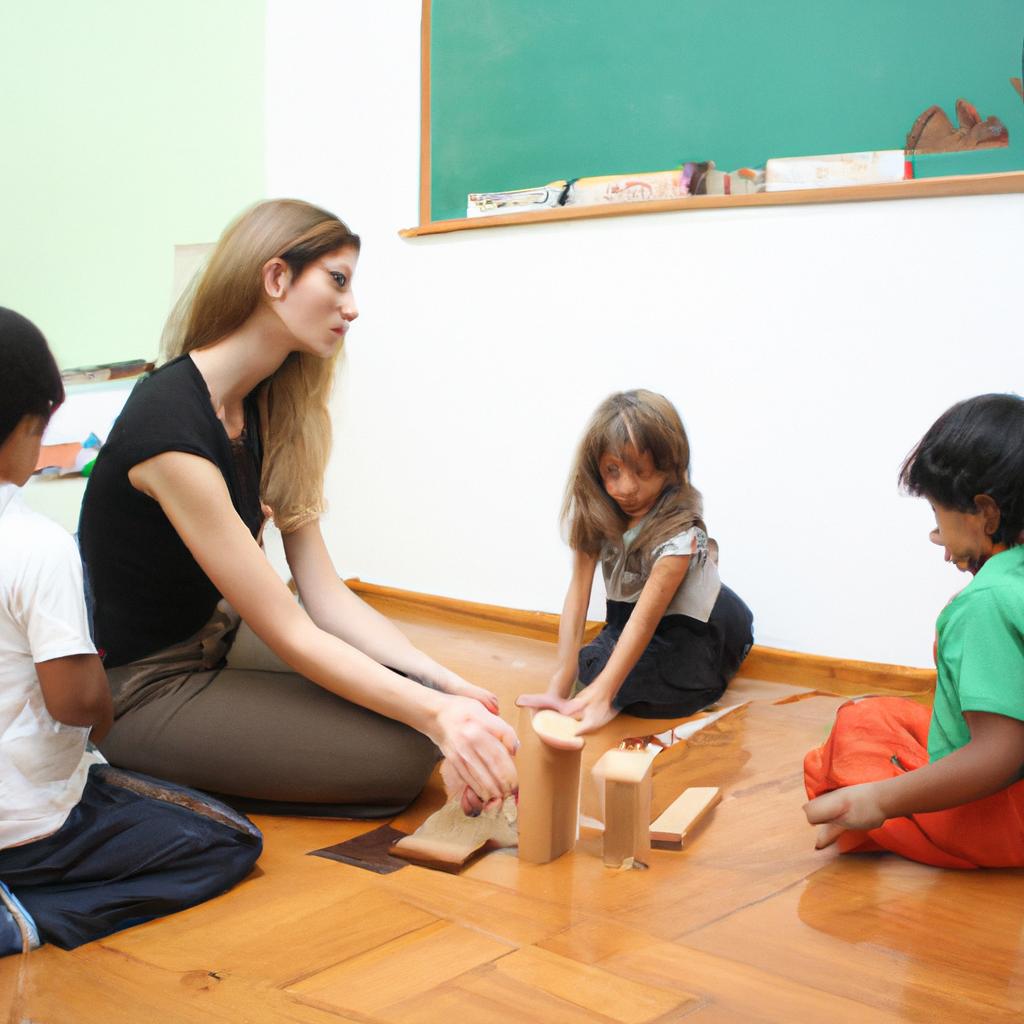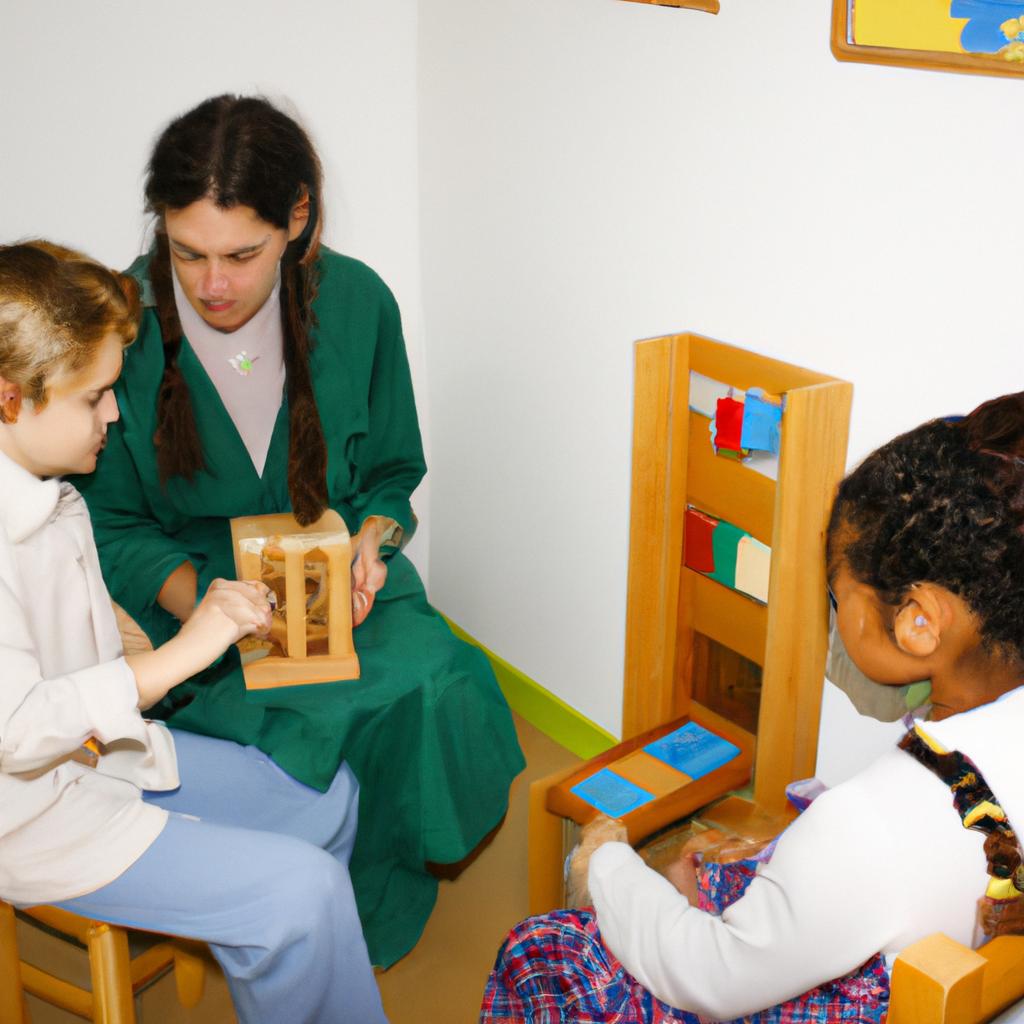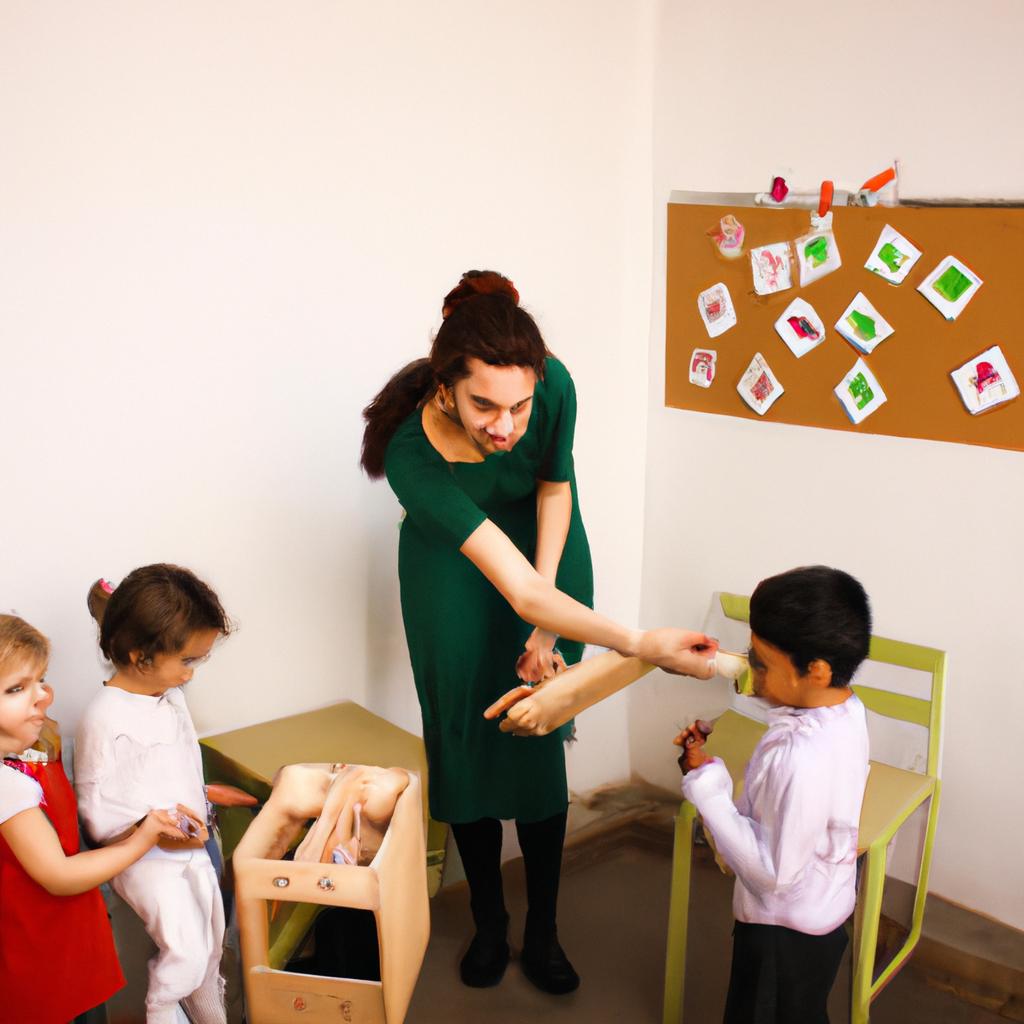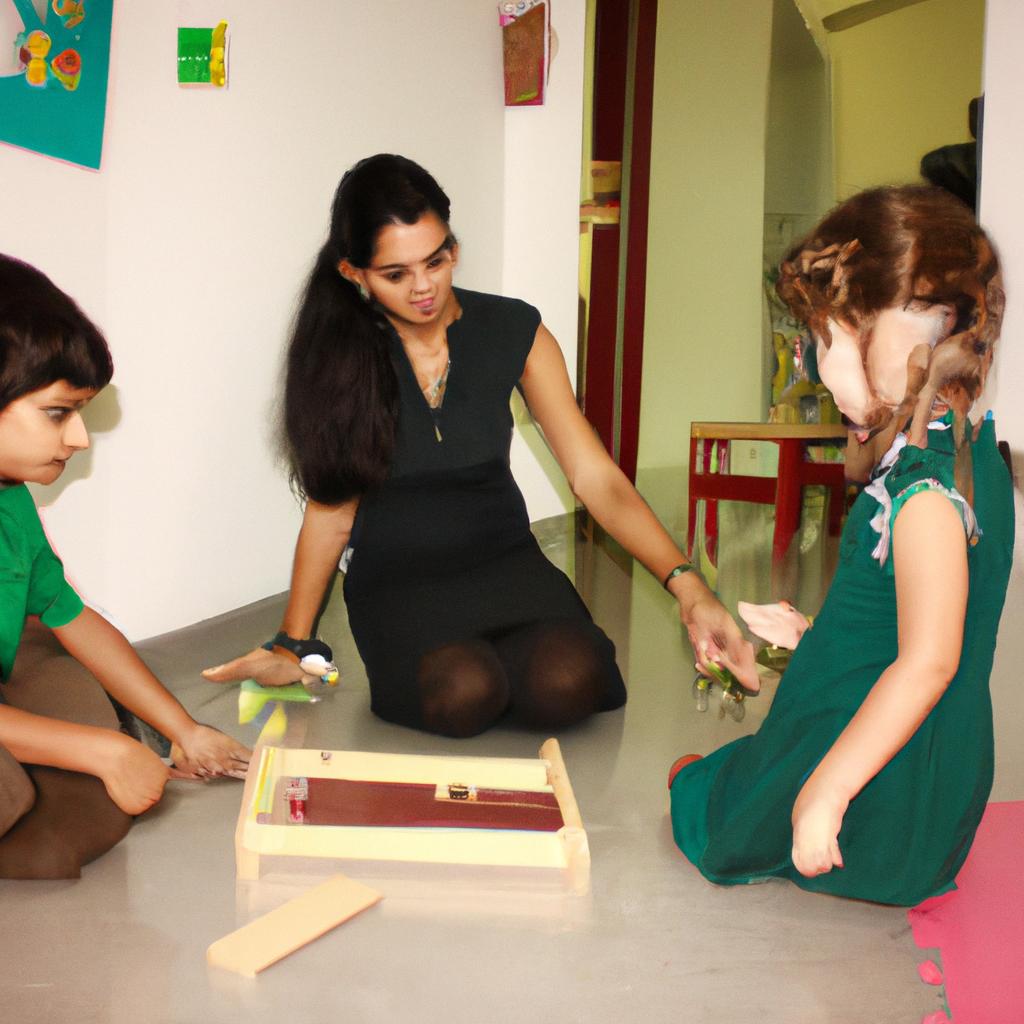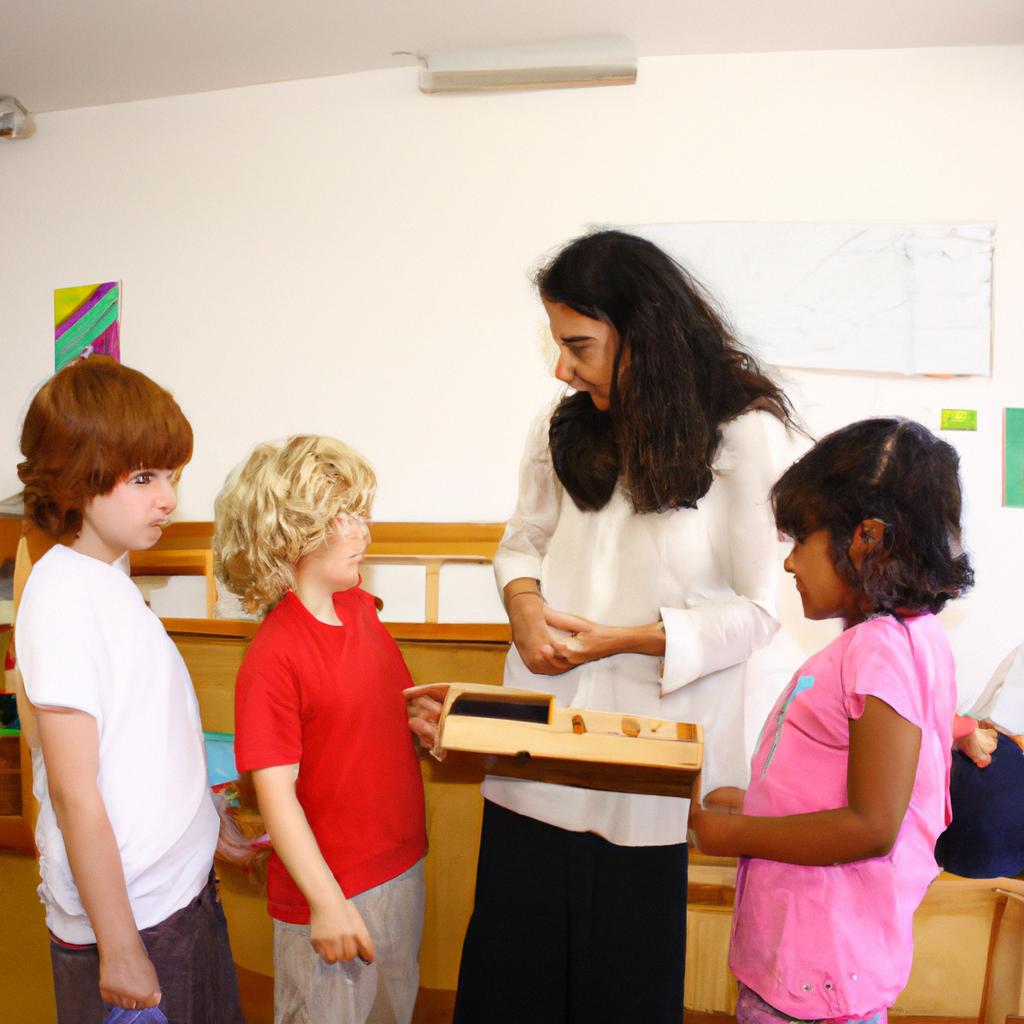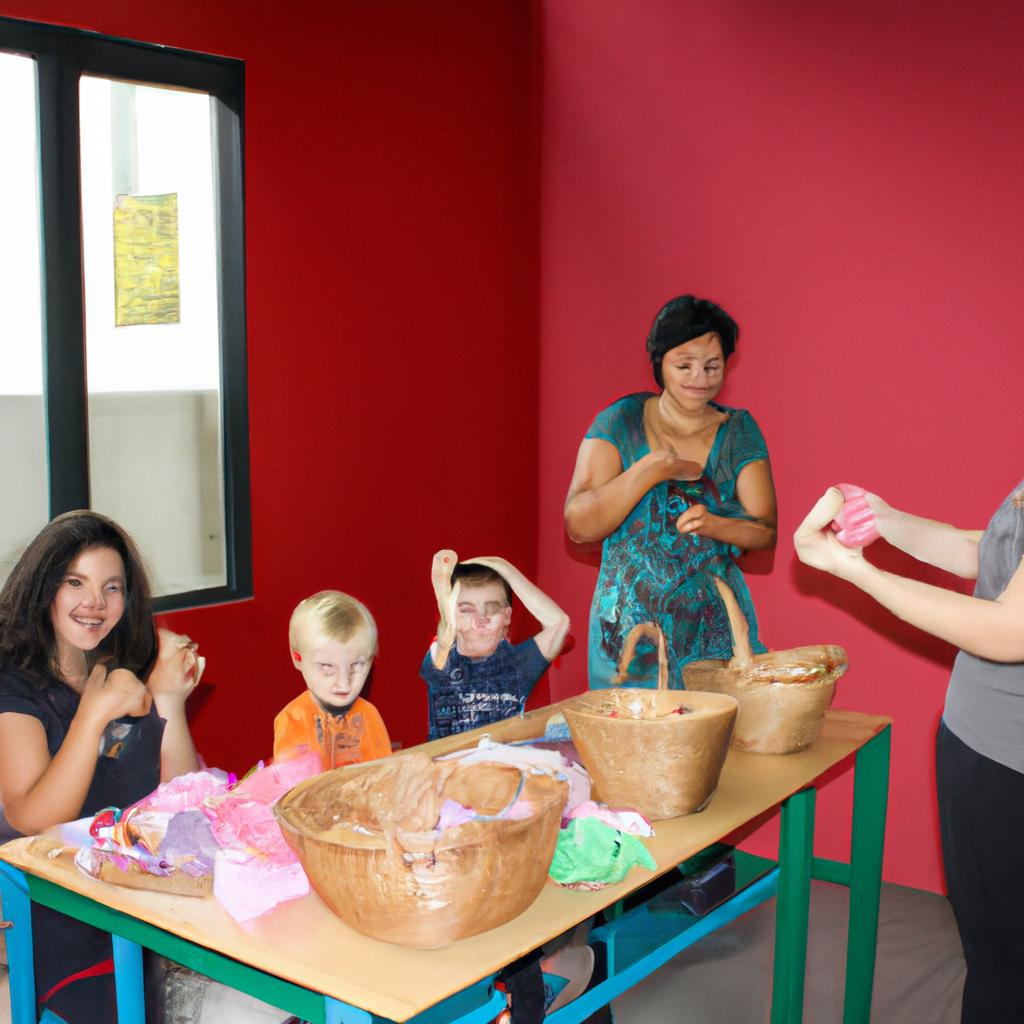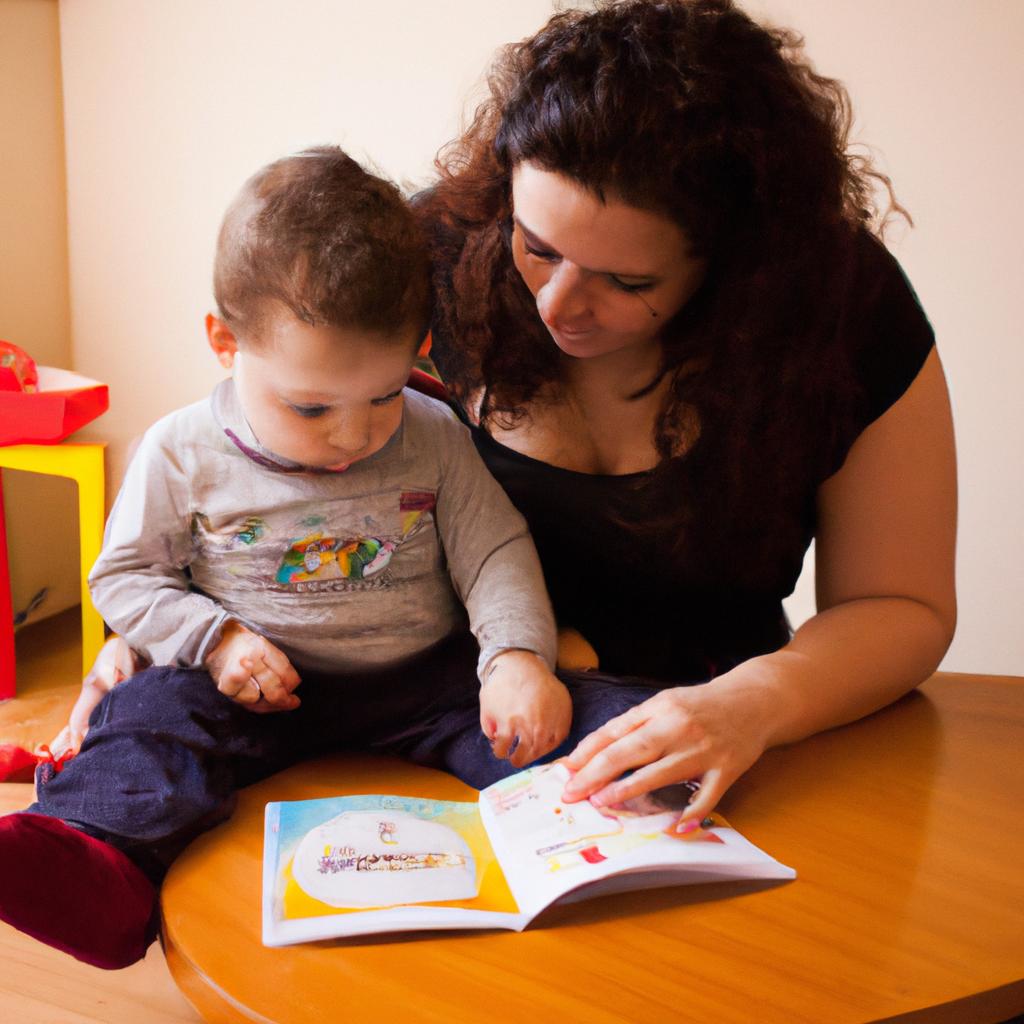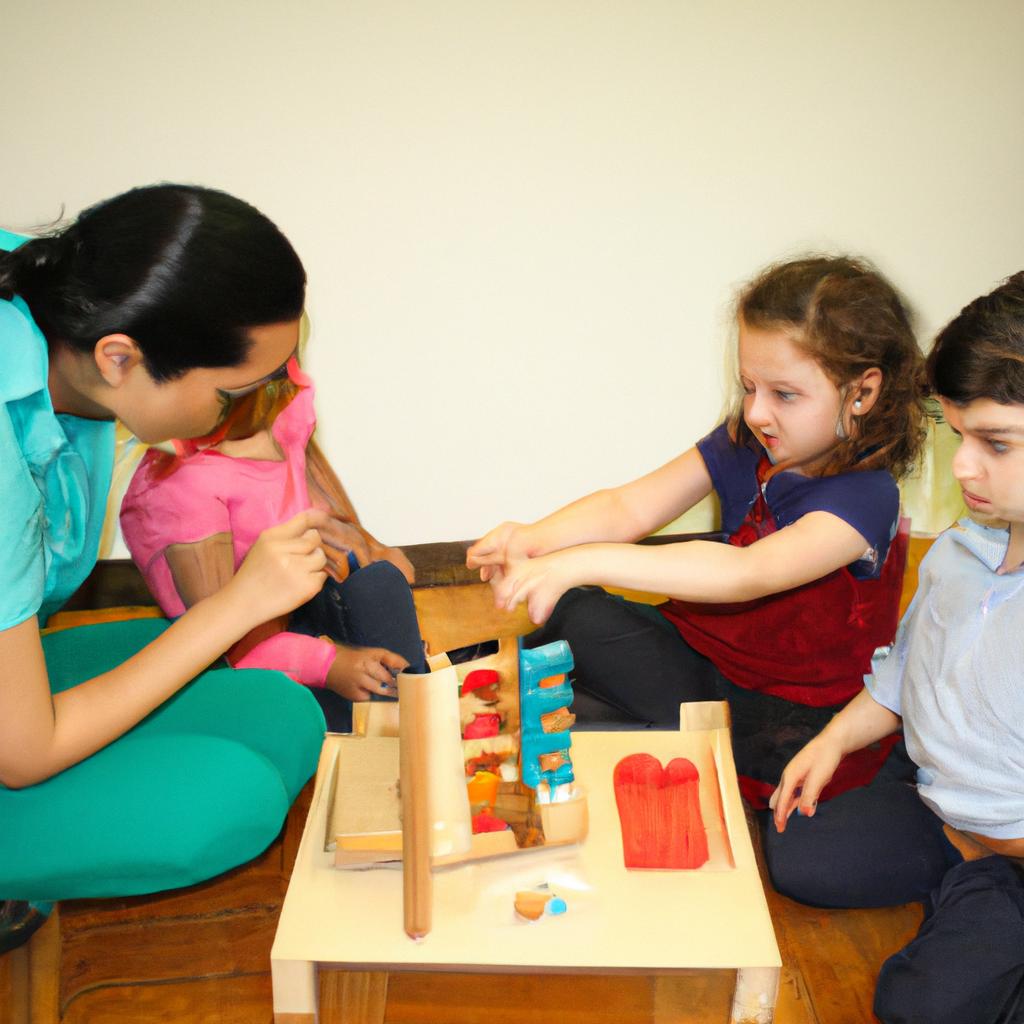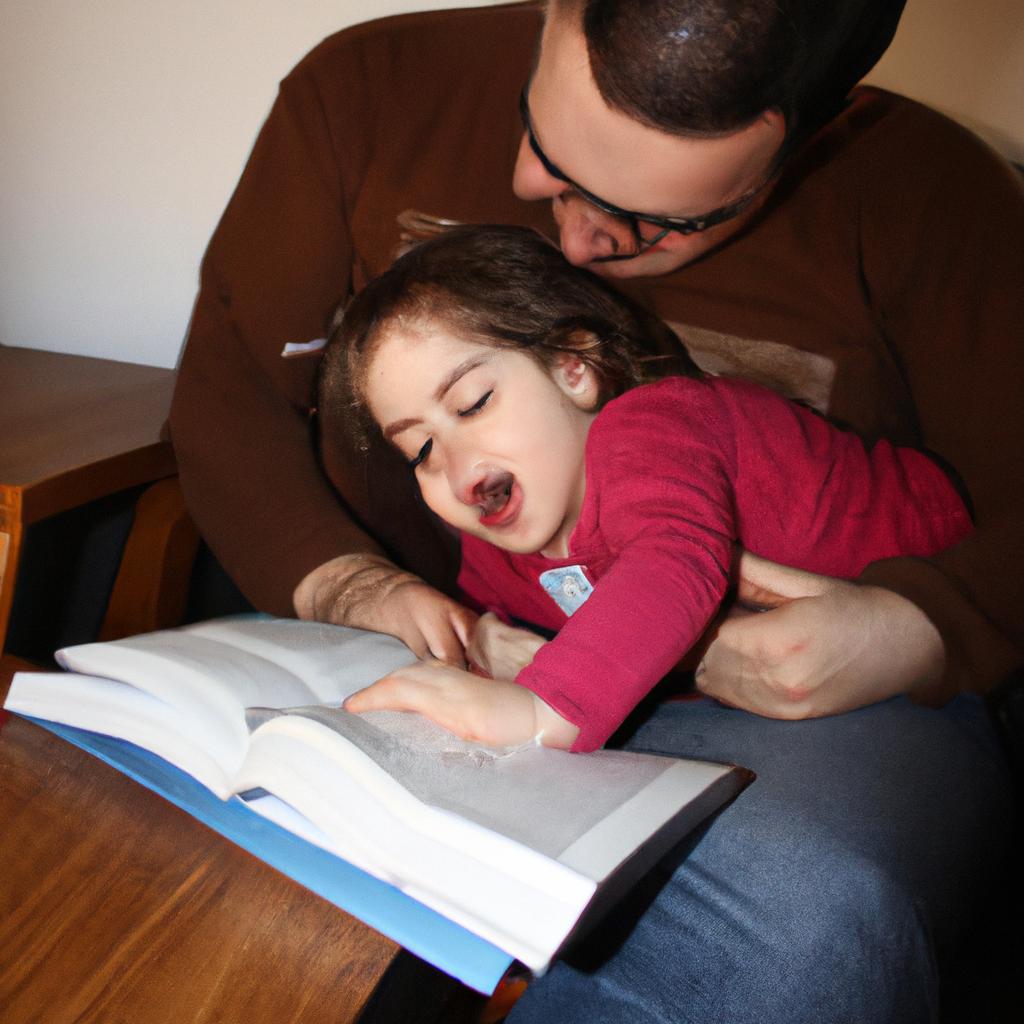Montessori education is renowned for its emphasis on individualized instruction, providing students with a unique learning experience tailored to their specific needs and interests. At the heart of this approach lies the Montessori teacher, who plays a pivotal role in facilitating and guiding the individualized learning journey of each student. Through careful observation, thoughtful planning, and targeted interventions, the Montessori teacher ensures that every learner thrives academically and socially.
For instance, let us consider an imaginary scenario: Sarah, a five-year-old student at a Montessori school, struggles with reading comprehension. Her teacher notices her struggle during one-on-one lessons and decides to implement various strategies to support her development. The teacher adjusts the pace of instruction according to Sarah’s abilities while incorporating different materials and activities specifically designed to enhance her reading skills. By tailoring the curriculum to address Sarah’s academic challenges directly, the Montessori teacher fosters an environment where she can progress at her own pace while receiving personalized guidance along the way.
The key responsibility of a Montessori teacher extends beyond delivering curriculum content; it involves recognizing each student’s unique strengths, weaknesses, and learning style. This article will explore further how Montessori teachers engage in ongoing assessment practices, adapt instructional methods, and foster a supportive learning environment to meet the individual needs of their students.
Montessori teachers engage in ongoing assessment practices to gain insights into each student’s progress and identify areas for improvement. They utilize observation techniques to closely monitor students’ interactions with materials, their problem-solving abilities, and their social and emotional development. Through careful observation, Montessori teachers can identify any challenges or gaps in a student’s understanding and adjust their instruction accordingly.
In addition to observations, Montessori teachers employ various assessment tools such as checklists, portfolios, and anecdotal records to gather evidence of student growth over time. These assessments provide valuable information about a student’s strengths, weaknesses, and interests, enabling the teacher to tailor instruction specifically to address individual needs.
Based on this ongoing assessment data, Montessori teachers adapt instructional methods to suit each student’s unique learning style. They create an environment rich in hands-on materials that cater to different modalities of learning – visual, auditory, kinesthetic. This multi-sensory approach allows students like Sarah to engage with concepts in ways that resonate with them personally. The teacher may introduce alternative strategies or resources tailored to an individual’s specific learning needs while still aligning with the overall goals of the curriculum.
Furthermore, Montessori teachers foster a supportive learning environment where students feel safe taking risks and making mistakes. They encourage independence by allowing children to choose activities that align with their interests while providing guidance when needed. This freedom within boundaries empowers students like Sarah to take ownership of their learning journey while receiving personalized support from the teacher as they navigate challenges.
Overall, Montessori teachers play a crucial role in facilitating individualized instruction by engaging in ongoing assessment practices, adapting instructional methods based on student needs, and creating a supportive learning environment. By recognizing and addressing each student’s unique strengths and weaknesses, these dedicated educators ensure that every learner receives personalized guidance on their path towards academic success.
Understanding the Montessori Approach
The Montessori approach to education is a child-centered method that emphasizes individualized instruction and hands-on learning. Developed by Maria Montessori in the early 20th century, this approach recognizes that each child has unique needs and interests, requiring personalized attention to foster their development.
To better comprehend the essence of the Montessori approach, let us consider an example: A four-year-old named Emma attends a Montessori preschool. In her classroom, she has access to various materials and activities carefully selected to facilitate her learning journey. One morning, Emma shows a keen interest in puzzles and spends a substantial amount of time engrossed in solving them independently. The Montessori teacher acknowledges Emma’s curiosity and provides appropriate guidance when needed, allowing her to explore and develop problem-solving skills at her own pace.
This student-driven approach aligns with several key principles of the Montessori philosophy:
- Respect for individuality: Each child is seen as a unique individual with distinct abilities, preferences, and developmental stages.
- Freedom within limits: Students are given freedom to choose their activities from a range of options while respecting boundaries set by the teacher.
- Prepared environment: The physical space is organized in a way that promotes independence, self-discovery, and orderliness.
- Hands-on learning: Children engage with concrete materials designed to promote sensorial experiences and enable active exploration.
By incorporating these principles into their teaching practices, Montessori teachers create an environment where children can thrive academically, socially, emotionally, and intellectually. This results in students who are confident learners equipped with essential life skills such as critical thinking, problem-solving abilities, adaptability, collaboration, and self-motivation.
Transitioning into the subsequent section about “The Importance of Observing Individual Needs,” it becomes evident that understanding each child’s specific requirements plays a crucial role in fostering their growth within the Montessori environment.
The Importance of Observing Individual Needs
Understanding the Montessori Approach allows us to delve into the role of a Montessori teacher in providing individualized instruction. In this section, we will explore how educators implement personalized learning experiences to cater to each child’s unique needs and abilities.
Consider a hypothetical scenario where a young student named Emily enters a Montessori classroom for the first time. The Montessori teacher carefully observes Emily as she engages with various materials in the prepared environment. Through these observations, the teacher gains insights into Emily’s interests, strengths, and areas that require further development.
To ensure effective individualized instruction, Montessori teachers employ several strategies:
-
Adaptability: Teachers adapt their approach based on each student’s readiness and pace of learning. For instance, if a child shows advanced proficiency in mathematics, they might be introduced to more complex concepts while another child may need additional support or reinforcement.
-
Materials and Manipulatives: The use of specially designed Montessori materials enables students to interact with abstract concepts through hands-on experiences. These materials are self-correcting, promoting independent problem-solving skills while fostering creativity and critical thinking.
-
Freedom within Limits: A crucial aspect of the Montessori philosophy is granting children autonomy within established boundaries. Students have the freedom to choose their activities from a range of options provided by the teacher, allowing them to follow their natural curiosity while also learning responsibility and self-discipline.
-
Individualized Lesson Plans: By closely observing each child’s progress and understanding their developmental stage, teachers create tailored lesson plans that address specific needs rather than adhering strictly to age-based curricula. This ensures that every learner receives appropriate challenges and guidance at all times.
These strategies exemplify how Montessori teachers personalize education for each child, fostering an engaging and enriching learning experience that promotes holistic growth across physical, emotional, social, cognitive, and creative domains.
As we move forward into discussing “Creating a Prepared Environment,” it is crucial to recognize that the Montessori approach transcends individualized instruction by encompassing an environment designed specifically to support and enhance each child’s learning journey.
Creating a Prepared Environment
Having discussed the importance of observing individual needs, we now turn our attention to creating a prepared environment that supports personalized learning experiences in Montessori education.
In a Montessori classroom, the physical space is carefully designed and organized to facilitate independent exploration and learning. The aim is to create an environment where children feel empowered to make choices based on their interests and developmental needs. For instance, let’s consider an example of a four-year-old student named Emma who shows a strong inclination towards mathematics. In her Montessori classroom, she has access to various math materials such as counting beads, number rods, and puzzle maps that allow her to explore mathematical concepts at her own pace.
To further understand how the prepared environment benefits students in Montessori education, below are some key elements that contribute to its effectiveness:
- Orderliness: The materials and activities in the classroom are arranged in an orderly manner, making it easier for children to locate what they need independently.
- Accessibility: Everything within the environment is easily accessible to young learners, promoting their autonomy and self-reliance.
- Beauty: Attention is given to aesthetics, with visually appealing materials and decorations that engage children’s senses and ignite their curiosity.
- Freedom of Movement: The layout of the classroom allows for freedom of movement so that children can choose workspaces according to their preferences or collaborate with peers when desired.
By providing these elements within a prepared environment, Montessori teachers empower students like Emma to take charge of their own learning journey. They have the opportunity to explore subjects deeply while also developing essential skills such as decision-making, organization, and time management.
The next section will delve into how Montessori teachers guide and facilitate learning experiences within this prepared environment without imposing rigid structures or traditional teaching methods.
Guiding and Facilitating Learning Experiences
Building upon the foundation of a prepared environment, Montessori teachers play a crucial role in guiding and facilitating individualized learning experiences for their students. By embracing the principles of self-direction and personalized instruction, they empower children to explore, discover, and grow academically and emotionally.
One example that highlights the effectiveness of individualized instruction in a Montessori classroom is Sarah’s journey. Sarah, a seven-year-old student with a keen interest in biology, was given the freedom to pursue her passion within the framework provided by her teacher. Through hands-on activities such as examining different plant specimens under a microscope or observing the life cycle of butterflies firsthand, she not only deepened her understanding of scientific concepts but also developed critical thinking skills and independence.
To further illustrate the benefits of individualized instruction in Montessori education, consider these emotional responses evoked:
- Excitement: Students are encouraged to follow their interests and passions.
- Confidence: Individualized learning allows students to progress at their own pace.
- Inclusion: All students’ unique needs and abilities are considered.
- Empowerment: Children develop a sense of ownership over their education.
| Emotional Responses | Benefits |
|---|---|
| Excitement | Follow interests & passions |
| Confidence | Progress at own pace |
| Inclusion | Consider unique needs |
| Empowerment | Develop ownership |
Montessori teachers employ various strategies to ensure effective individualized instruction. Firstly, through continuous observation and assessment, they identify each child’s strengths, weaknesses, and specific learning styles. This information guides them in tailoring instructional materials and activities accordingly.
Secondly, Montessori teachers create an atmosphere that fosters autonomy while providing gentle guidance when needed. They respect children’s choices and encourage independent decision-making while gently redirecting them towards productive tasks or areas where growth is necessary.
Lastly, Montessori teachers serve as facilitators by introducing new concepts and materials, modeling appropriate behavior, and offering support whenever children encounter challenges. They strive to create a nurturing environment that promotes collaboration, problem-solving skills, and respect for oneself and others.
By promoting independence and self-discipline, Montessori teachers empower their students to take ownership of their learning journey.
Promoting Independence and Self-Discipline
Building upon the guiding and facilitating learning experiences, Montessori teachers also play a crucial role in promoting independence and self-discipline among their students. By creating an environment that fosters individualized instruction, these educators empower children to take ownership of their learning journey.
One example of how a Montessori teacher promotes independence is through the use of practical life activities. These activities include tasks such as pouring water, buttoning shirts, or tying shoelaces. By providing opportunities for children to engage in real-life tasks, they develop essential skills while gaining confidence in their abilities. For instance, consider a hypothetical scenario where a five-year-old student struggles with buttoning his shirt independently at the beginning of the school year. Through patient guidance and consistent practice within the classroom setting, the child gradually gains mastery over this skill, leading to increased self-confidence.
To further promote independence and self-discipline, Montessori teachers employ various strategies:
- Encouraging choice-making: Students are given choices within structured parameters, allowing them to exercise decision-making skills.
- Providing uninterrupted work periods: Extended blocks of uninterrupted time enable students to fully immerse themselves in activities without external distractions.
- Establishing clear expectations: Teachers communicate guidelines and rules clearly so that students understand what is expected from them.
- Offering freedom within limits: While students have autonomy over their learning experience, they learn about boundaries and respect for others’ rights.
- Empowerment
- Confidence-building
- Sense of accomplishment
- Self-motivation
| Strategies for Promoting Independence | Benefits |
|---|---|
| Encouraging choice-making | – Develops decision-making skills- Fosters sense of autonomy |
| Providing uninterrupted work periods | – Enhances concentration- Supports deep engagement |
| Establishing clear expectations | – Promotes understanding of boundaries- Cultivates responsible behavior |
| Offering freedom within limits | – Encourages self-regulation- Nurtures respect for others’ rights |
In conclusion, Montessori teachers play a vital role in promoting independence and self-discipline among their students. By providing practical life activities and implementing various strategies such as encouraging choice-making and establishing clear expectations, these educators create an environment that fosters individualized instruction. Through this approach, children develop essential skills and gain confidence in their abilities, fostering a sense of empowerment and motivation to explore further.
Moving forward into the subsequent section on collaborating with parents and caregivers…
Collaborating with Parents and Caregivers
Promoting Independence and Self-Discipline in the Montessori classroom is just one aspect of a Montessori teacher’s role. Another crucial responsibility involves collaborating with parents and caregivers to ensure holistic development for every child.
One example that illustrates this collaborative approach is when a parent expresses concerns about their child’s struggle with self-regulation at home. The Montessori teacher, equipped with knowledge on individualized instruction, can work together with the parent to develop strategies that promote self-discipline both in school and at home. By understanding the unique needs and challenges of each child, the teacher can provide tailored guidance to support their growth in areas such as emotional regulation or time management.
Collaborating effectively with parents and caregivers requires open communication and active engagement. Here are some key practices that Montessori teachers employ:
- Regular Parent-Teacher Conferences: These formal meetings allow for detailed discussions on a child’s progress, strengths, challenges, and goals. It provides an opportunity for teachers to share observations from the classroom while also gaining valuable insights from parents regarding the child’s behavior or learning patterns at home.
- Home-School Collaboration Projects: Engaging parents in collaborative projects fosters a sense of community between school and home environments. For instance, organizing joint activities like family literacy nights or volunteering opportunities allows parents to actively participate in their child’s education journey.
- Sharing Resources and Information: A Montessori teacher understands that building strong partnerships means providing resources beyond the confines of the classroom. Teachers may create newsletters or online platforms where they share articles, books recommendations, or other relevant information to help parents further support their child’s development.
- Responsive Communication Channels: Establishing clear lines of communication ensures prompt feedback exchange between teachers and parents/caregivers. Whether through email updates, phone calls, or digital platforms like messaging apps or dedicated portals, maintaining regular contact helps address any emerging concerns promptly.
Through these collaborative efforts, Montessori teachers aim to create a supportive and unified environment that nurtures every child’s growth. By recognizing the importance of involving parents and caregivers in their educational journey, Montessori education becomes an experience where learning extends beyond the classroom walls.
| Key Practices for Collaboration | |
|---|---|
| 1 | Regular Parent-Teacher Conferences |
| 2 | Home-School Collaboration Projects |
| 3 | Sharing Resources and Information |
| 4 | Responsive Communication Channels |
In summary, promoting independence and self-discipline is just one aspect of a Montessori teacher’s role. Collaborating with parents and caregivers plays a crucial part in ensuring holistic development for each child. Through practices such as regular conferences, collaborative projects, resource sharing, and responsive communication channels, Montessori teachers build strong partnerships with parents to support children’s growth both inside and outside the classroom. By working together towards common goals, the Montessori approach becomes a truly comprehensive educational experience for young learners.

